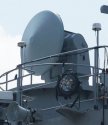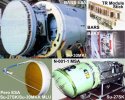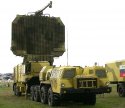The proposed upgrade past the N001VEP was the VEP+Pero upgrade, also code named "Panda", which implies the primary market of intention is China.
Panda retains the N001VEP but replaces the twist cassegrain with a PESA, and then retaining the rest with some electronic upgrades. In actuality the main antenna structure of the N001VEP is preserved but the reflectors are changed.
To understand what a cassegrain is.
You have two reflectors facing each other, one much smaller than the main one, and the emitter or feeder is in a hole. The emitter shines through the hole, into the smaller secondary reflector which then reflects the radio waves into the main reflector that forms the beam. This design is common with all forms of radar, radio telescopes, even reflective telescopes.
In the Twist Cassegrain, the feeder is offset to the side of the disk that makes up the main reflector, and the secondary reflector is angled. As the main reflector is rotated, so is the emitter going around and around, as well as the secondary reflector.
If you are looking at the main reflector itself, it would look like this.

That one is actually for the MiG-23's radar.
When complete, it would look like this. You can see the angled secondary reflector in the foreground. The reflector also lets radio waves passes through using polarization.

By "twisting" around, the radar scans both vertically and horizontally.
A variation is used with naval gun fire control radars, which looks like two coned dishes combined into each other. For example this Chinese Type 344 radar.

Now we go to the Pero. It looks like this on the bottom right corner.

This is a PESA but a different kind of PESA. Its called a Spaced PESA. With PESA, the emitter is in the back of the array, and the radio waves pass through the elements which form the beam through interference. BARS above is a good example of this PESA, and the understanding of what a PESA is is defined by this type.
With a Spaced PESA, the emitter is in a feeder horn in front of the array. It shines on the array, which then reflects it back. The elements on the array itself would then form the beam through interference.
Pero is intended as a midlife upgrade to the N001V, VE and VEP radars, and its never known that it was adopted, unlikely so.
Spaced PESA is also used in one of the S-300 radars, I believe this is Clamshell. I don't believe that any Chinese radar, in particular the HT-233 used to support the HQ-9, ever used this design.

Panda retains the N001VEP but replaces the twist cassegrain with a PESA, and then retaining the rest with some electronic upgrades. In actuality the main antenna structure of the N001VEP is preserved but the reflectors are changed.
To understand what a cassegrain is.
You have two reflectors facing each other, one much smaller than the main one, and the emitter or feeder is in a hole. The emitter shines through the hole, into the smaller secondary reflector which then reflects the radio waves into the main reflector that forms the beam. This design is common with all forms of radar, radio telescopes, even reflective telescopes.
In the Twist Cassegrain, the feeder is offset to the side of the disk that makes up the main reflector, and the secondary reflector is angled. As the main reflector is rotated, so is the emitter going around and around, as well as the secondary reflector.
If you are looking at the main reflector itself, it would look like this.

That one is actually for the MiG-23's radar.
When complete, it would look like this. You can see the angled secondary reflector in the foreground. The reflector also lets radio waves passes through using polarization.

By "twisting" around, the radar scans both vertically and horizontally.
A variation is used with naval gun fire control radars, which looks like two coned dishes combined into each other. For example this Chinese Type 344 radar.

Now we go to the Pero. It looks like this on the bottom right corner.

This is a PESA but a different kind of PESA. Its called a Spaced PESA. With PESA, the emitter is in the back of the array, and the radio waves pass through the elements which form the beam through interference. BARS above is a good example of this PESA, and the understanding of what a PESA is is defined by this type.
With a Spaced PESA, the emitter is in a feeder horn in front of the array. It shines on the array, which then reflects it back. The elements on the array itself would then form the beam through interference.
Pero is intended as a midlife upgrade to the N001V, VE and VEP radars, and its never known that it was adopted, unlikely so.
Spaced PESA is also used in one of the S-300 radars, I believe this is Clamshell. I don't believe that any Chinese radar, in particular the HT-233 used to support the HQ-9, ever used this design.

Last edited:




